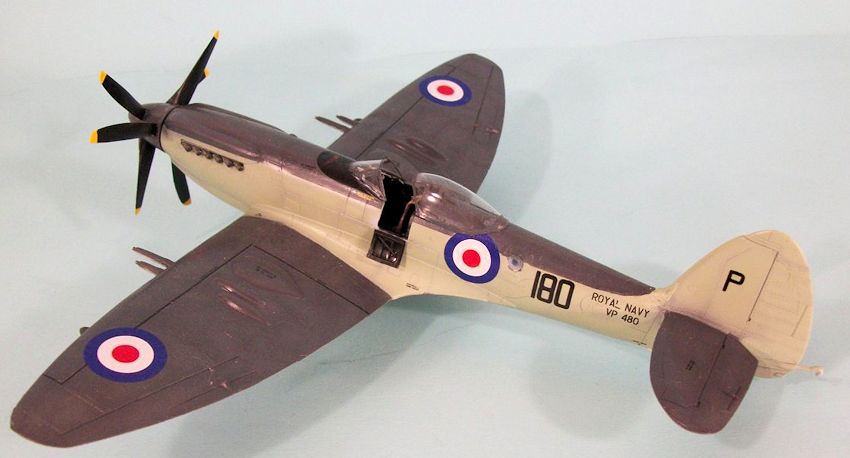
Airfix 1/48 Seafire FR.47
| KIT #: | A06103 |
| PRICE: | $ |
| DECALS: | Two options |
| REVIEWER: | Tom Cleaver |
| NOTES: |
Falcon vacuform canopy used |

| HISTORY |
On 25 June 1950, the North Korean invasion of South Korea found the
United States in a greater state of military unpreparedness than had the
Japanese attack on Pearl Harbor nine and a half years earlier.
In the wake of the creation of the Department of Defense in 1948, a
decision meant to unify the armed forces, the unification arguments of the
preceding year, combined with President Truman’s desire to cut military spending
to levels not seen since before 1941, had the military service in disarray.
President Truman’s decision to intervene in Korea caught the U.S. Navy
even more unprepared for combat in the Far East than the other services. In the
years following the end of the Second World War, the Navy and Marine Corps had
been drastically reduced. In the aftermath of the creation of the Air Force as
an independent co-equal service, and the creation of the Department of Defense
to unify the armed forces, there had been a series of political battles over the
dominance of the Air Force as the prime delivery force of the U.S. nuclear
arsenal. Following the cancellation of the new aircraft carrier USS United
States in 1949, there had been a real fear that Naval Aviation would be
transferred to the Air Force, while the Marine Corps was inducted into the Army.
The Navy was so reduced by budget constraints that before January 1950,
no U.S. aircraft carrier had operated west of Hawaii since 1947. USS Boxer
(CV-21) had deployed to the Far East on 11 January,
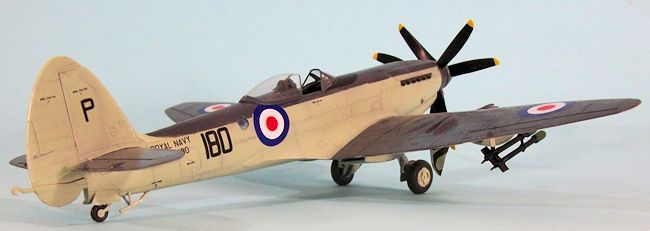 returning to
the United States on 13 June when she was relieved by USS Valley Forge
(CV-47). Additionally, since there
were no major operating facilities for naval ships in Japan, the Seventh Fleet
was based at Subic Bay in the Philippines, distant from Korea.
Fortunately, Air Group 5 aboard Valley force was the most modern naval
air group, with two squadrons of F9F-2 Panthers, two squadrons of F4U-4B
Corsairs, and a squadron of new AD-4 Skyraiders.
E
returning to
the United States on 13 June when she was relieved by USS Valley Forge
(CV-47). Additionally, since there
were no major operating facilities for naval ships in Japan, the Seventh Fleet
was based at Subic Bay in the Philippines, distant from Korea.
Fortunately, Air Group 5 aboard Valley force was the most modern naval
air group, with two squadrons of F9F-2 Panthers, two squadrons of F4U-4B
Corsairs, and a squadron of new AD-4 Skyraiders.
E
The only other naval force in the Far East was the Royal Navy squadron at
Hong Kong. The Royal Navy had been
subject to even greater post-war economies than had the U.S. Navy.
A singly light carrier, HMS Triumph, had operated in the Far East
since the preceding December and was preparing to return to Britain.
Triumph’s Carrier Air Wing 13 consisted of 800 Squadron’s 12
obsolescent Seafire 47 fighters and 827 Squadron’s 12 obsolete Firefly I light
attack bombers.
Acting on his own on 26 June, Rear Admiral Sir William G. Andrewes, RN, commander of the Royal Navy’s Far Eastern Fleet, departed Hong Kong at 0130 hours, directing his ships to concentrate in Southern Japanese ports. HMS Triumph was nearing Hong Kong after flying missions in support of Operation Firedog, the battle with communist guerillas in Malaya. The two formations met at sea, Triumph joining the heavy cruisers HMS Jamaica and Belfast, flying Admiral Andrewes’ flag, destroyers Cossack and Consort, and frigates Black Swan, Alacrity, Hart and Shoalhaven, with the Australian HMAS Bataan. The Commonwealth fleet arrived at the Royal Australian Navy base in Kure, Japan, on 28 June. By 29 June, all Commonwealth forces in the Far East as well as Canada had been ordered to participate in the UN force. Task Force 77 (the official designation of the Seventh Fleet Striking Force) had departed Subic Bay on 27 June, and arrived at Buckner Bay, Okinawa, on 30 June, where it was joined the next day by the Commonwealth fleet.

At 0130 hours on the morning of 30 June, Ambassador Muccio notified
Acheson that “things were desperate on the peninsula,” and that MacArthur was
going to formally request the authority to commit ground troops. The General’s
cable to the Joint Chiefs arrived 90 minutes later. His words were fateful: “The
only assurance for holding of the present line, and the ability to regain the
lost ground, is through the introduction of U.S. ground forces into the Korean
battle area. To continue to utilize the forces of our Air and Navy without an
effective ground element cannot be decisive.”
With the President’s approval, the 24th Infantry Division was ordered to
establish a Regimental Combat Team for transfer to Korea. On 1 July, the two
squadrons of B-29s in the Far East flew from Guam to Kadena Air Base on Okinawa,
where they prepared to commence bombing operations in North Korea as soon as
possible.
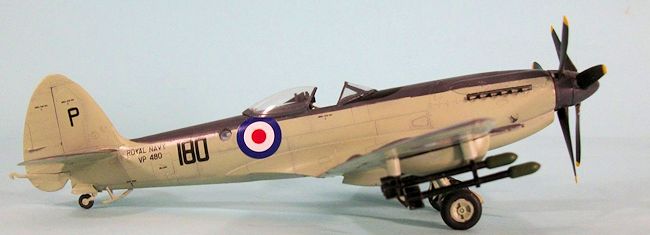 The combined fleet sortied from Okinawa on 1 July, with the British
cruisers and frigates, now designated Task Group 96.8, the West Korean Support
Group, departing to reinforce the American fire support group off the coast of
South Korea. Task Force 77 was
ordered to strike the North Korean capital of Pyongyang.
The combined fleet sortied from Okinawa on 1 July, with the British
cruisers and frigates, now designated Task Group 96.8, the West Korean Support
Group, departing to reinforce the American fire support group off the coast of
South Korea. Task Force 77 was
ordered to strike the North Korean capital of Pyongyang.
By dawn on 3 July, Task Force 77 had reached the middle of the Yellow
Sea, 150 miles from their North Korean target, but only 100 miles from Chinese
airfields on the Shantung Peninsula and less than 200 miles from the Soviet air
base at Port Arthur. At 0500 hours, USS Valley Forge launched combat air
and anti-submarine patrols. At 0545 hours, HMS Triumph launched nine
Seafires and twelve Fireflies to attack the airfield at Haeju. At 0600 hours,
Valley Forge launched sixteen Corsairs from VF-53 and VF-54, and twelve
Skyraiders from VA-55 against Pyongyang airfield. When the propeller planes had
gained a suitable head start, Valley Forge catapulted eight F9F‑2
Panthers of VF-51 that would be the first aircraft over the target. When the
American jets swept over the North Korean capital, two airborne Yak-9s were
spotted and destroyed, with another damaged, while nine aircraft were reported
destroyed on the ground by strafing attacks. The Corsairs and Skyraiders
followed the Panthers, bombing hangars and fuel storage at Pyongyang airfield
while the British force hit nearby Haeju. Anti-aircraft opposition was
negligible, and the attackers suffered no damage or loss. That afternoon,
aircraft from Triumph flew a second strike against railroad lines, while
Valley Forge launched a second strike against the rail marshaling yards
in Pyongyang and the bridges over the Taedong River. Considerable damage was
inflicted on locomotives and rolling stock, but the bridges survived. In view of
the “rapidly deteriorating Korean situation,” as General MacArthur reported it,
additional strikes were flown on 4 July, with further damage inflicted on
railroads while one bridge over the Taedong was knocked down. Four Skyraiders
were damaged in these final strikes.
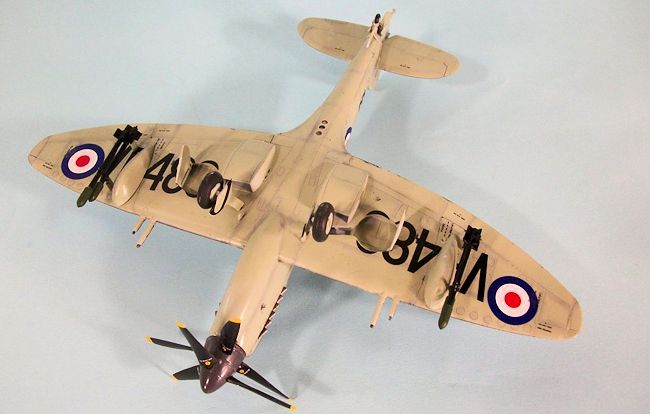 The sudden appearance of U.S. and British aircraft more than 400 miles
from the nearest American airfield was a rude awakening for the North Koreans.
Indeed, the attacks may have deterred a sizable commitment of Soviet aircraft to
North Korean bases that week, for which the North Koreans had been negotiating
since the outbreak of war. In addition to deterring immediate Soviet
participation in the war, the value of carrier striking forces had been proven
once again and would never again be seriously questioned. The U.S. Navy had won
the political argument over service integration; there would never again be any
proposals to abolish naval aviation.
The sudden appearance of U.S. and British aircraft more than 400 miles
from the nearest American airfield was a rude awakening for the North Koreans.
Indeed, the attacks may have deterred a sizable commitment of Soviet aircraft to
North Korean bases that week, for which the North Koreans had been negotiating
since the outbreak of war. In addition to deterring immediate Soviet
participation in the war, the value of carrier striking forces had been proven
once again and would never again be seriously questioned. The U.S. Navy had won
the political argument over service integration; there would never again be any
proposals to abolish naval aviation.
For the rest of the month of July, the short-ranged Seafires were used
for air defense of the fleet, while the Fireflies operated as spotter aircraft
for the surface fleet gunfire support units as they attacked the North Korean
transport system. Following the
stabilization of the front at the Pusan Perimeter, the Fleet Air Arm aircraft
participated fully in support of UN ground forces in the desperate fight to hold
off the North Korean Army. Over the
course of August and early September, all Firefly I aircraft in the Far East
were used up in operations, along with the nine Seafire 47s available for
replacement. By the time HMS
Triumph departed the Far East to return to Britain, 800 Squadron had only five
Seafires that could be flown under relaxed safety rules; all of the Seafires had
been so badly damaged structurally by their hard use aboard the carrier that
they were written off and junked upon arrival home.
Carrier Air Wing 13 had performed “above and beyond” in preventing
catastrophe in the opening months of the Korean War.
| THE KIT |
Airfix released the Seapfire 46/47 and Spitfire 22/24 kits in 1996.
These Spitfire and Seafire sub-types had long been wanted by modelers and
the kits represented a real boost to Airfix’s line of kits as
 regards
production quality and accuracy.
The only real complaint modelers had was that the decal sheets were not up to
the quality of the rest of the kit.
Last fall, Airfix re-released the Seafire 46/47 kit, with high-quality new
decals printed by Cartograf.
regards
production quality and accuracy.
The only real complaint modelers had was that the decal sheets were not up to
the quality of the rest of the kit.
Last fall, Airfix re-released the Seafire 46/47 kit, with high-quality new
decals printed by Cartograf.
There are minor glitches to the kits in terms of accuracy, most of which
most modelers can live with. The
one thing that is really needed, however, is a corrected canopy, since what is
there is incorrect in shape and results in an off-putting “sit” with the model
completed. Fortunately, Falcon made
a vacuform canopy for the Seafire that is completely correct.
This is also avalable as a Squadron Canopy from Squadron Hobbies.
| CONSTRUCTION |
The kit goes together with little problem.
I advise that if you are going to do the Seafire 47 with the wings
unfolded that you use a strip of sheet plastic inside the joint between inner
and outer wing, and glue upper and lower surfaces together before further
assembly of the wing subassembly.
Everything will fit right if you do that. The portholes for the cameras in the
rear fuselage are not a good fit. I
used Micro Krystal-Klear glue for these.
In Korea, the Seafires of 800 Squadron used the “combat” slipper tanks on
the outer wing to provide necessary range, with only one set of rocket rails
mounting two rockets under each wing, so assemble accordingly.
| COLORS AND MARKINGS |
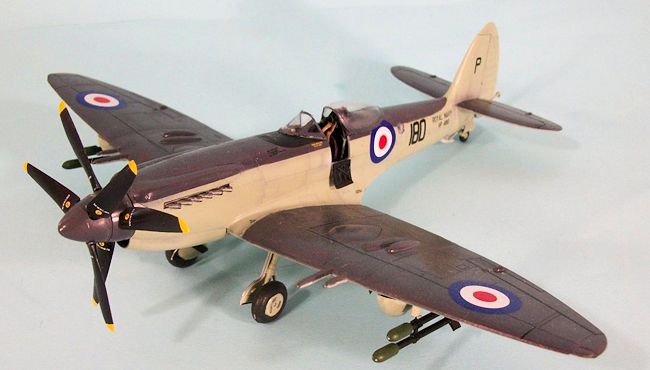 this model.
Most modelers will elect to use the decals, which make for a colorful
model as a result.
this model.
Most modelers will elect to use the decals, which make for a colorful
model as a result.
I painted the Extra Dark Sea Grey upper surfaces first, then masked them
off and painted the rest of the model with Sky, using Xtracrylix paints.
I then gave the model a coat of Xtracrylix Gloss varnish and applied the
decals. The new kit decals go one
without problem and melt down into the surface under a coat of Micro-Sol. After
the decals set, I washed off the model and applied a coat of Xtracrylix Satin
varnish, which looks better as a ‘gloss” finish in scale.
The prop blades were given a coat of Xtracrylix Flat varnish.
I unmasked the canopy and installed it in the open position, attaching
the side flap open. I attached the
counter-rotating prop and the underwing ordnance and drop tanks.
| CONCLUSIONS |
Copyright ModelingMadness.com. All rights reserved. No reproduction in any form without express permission.
If you would like your product reviewed fairly and fairly quickly, please contact the editor or see other details in the Note to Contributors.